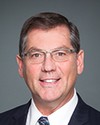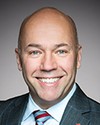Exactly.
Evidence of meeting #13 for Indigenous and Northern Affairs in the 42nd Parliament, 1st Session. (The original version is on Parliament’s site, as are the minutes.) The winning word was nurses.
A video is available from Parliament.
Evidence of meeting #13 for Indigenous and Northern Affairs in the 42nd Parliament, 1st Session. (The original version is on Parliament’s site, as are the minutes.) The winning word was nurses.
A video is available from Parliament.
4:20 p.m.
Senior Assistant Deputy Minister, First Nations and Inuit Health Branch, Department of Health
Exactly.
4:20 p.m.
Conservative

Kevin Sorenson Conservative Battle River—Crowfoot, AB
We all like those facts laid out. We like them all on the table.
Could you also give us the current proportion of Health Canada nurses who have completed the mandatory training courses. Is it back where it should be?
4:25 p.m.
Director, Primary Health Care Systems Division, Department of Health
As I indicated 55% of all the nurses have met the mandatory requirements—and our goal is 100%.
4:25 p.m.
Conservative
4:25 p.m.
Director, Primary Health Care Systems Division, Department of Health
Our goal is by the end of this fiscal year.
4:25 p.m.
Liberal

The Chair Liberal Andy Fillmore
Thank you. That'll be good. We appreciate that.
The final questioner we have time for is Mike Bossio, please.
4:25 p.m.
Liberal

Mike Bossio Liberal Hastings—Lennox and Addington, ON
Thank you all once again for being here today and providing this very valuable information. As Charlie said, we have so many questions.
What per cent of Health Canada employees are indigenous?
4:25 p.m.
Senior Assistant Deputy Minister, First Nations and Inuit Health Branch, Department of Health
This is an interesting question.
I cannot answer for Health Canada as a whole, but in our branch there are 2,400 employees across the country. I think our rate is around 26%. We have an objective to reach around 30% in the next four years.
4:25 p.m.
Liberal

Mike Bossio Liberal Hastings—Lennox and Addington, ON
What about in the executive branch of your department?
4:25 p.m.
Senior Assistant Deputy Minister, First Nations and Inuit Health Branch, Department of Health
I don't have that ratio. We have an aboriginal management development program to increase the number of indigenous people in the executive level.
4:25 p.m.
Liberal

Mike Bossio Liberal Hastings—Lennox and Addington, ON
What per cent of nurses and doctors are of indigenous backgrounds?
4:25 p.m.
Director, Primary Health Care Systems Division, Department of Health
Currently 24% of nurses self-identify as indigenous.
4:25 p.m.
Liberal

Mike Bossio Liberal Hastings—Lennox and Addington, ON
I assume that resources are dedicated very specifically toward recruiting and training indigenous nurses to work in their communities?
4:25 p.m.
Assistant Deputy Minister, Regional Operations, Department of Health
To supplement Mr. Perron's response on your question about the executives, I know there are five senior indigenous executives in the branch.
4:25 p.m.
Liberal

Mike Bossio Liberal Hastings—Lennox and Addington, ON
Is there a program dedicated to recruitment and training of indigenous nurses and health staff?
4:25 p.m.
Director, Primary Health Care Systems Division, Department of Health
It is not as specific, as we will take any and all nurses within the organization. It's very broad recruitment and retention. We do work with the Aboriginal Nurses Association of Canada in the promotion of indigenous individuals entering nursing, regardless of the employers.
4:25 p.m.
Liberal

Mike Bossio Liberal Hastings—Lennox and Addington, ON
From an educational standpoint, is there any specific program trying to steer indigenous youth to either health programs or skilled trades on the health side?
4:25 p.m.
Senior Assistant Deputy Minister, First Nations and Inuit Health Branch, Department of Health
There are a number of specialized programs, but in the health sector several universities or colleges have identified this as one of the segments of the population they want to bring in. We have a program, the aboriginal health human resources initiative, that provides $3 million a year in bursaries through the Indspire Foundation.
4:25 p.m.
Liberal

Mike Bossio Liberal Hastings—Lennox and Addington, ON
Part of the problem with that is the fact that you take them out of their communities and they become integrated into other communities or they don't go back.
Given the technology that's available today to deliver programs online, are there online programs that can be utilized to train nurses? Yes, you need to bring them to the centres to do practicums, but most of the training can occur within their own communities today.
4:25 p.m.
Senior Assistant Deputy Minister, First Nations and Inuit Health Branch, Department of Health
Even for the mandatory training that my colleague Leila was talking about, we have to bring them out to do the practice side. Nursing is a practice-oriented learning process. Technology can be used for some theory, but it's usually done in the universities and colleges.
We are using telehealth for training, but it's more like specific time-limited training activities to update their skills on some subject—
4:25 p.m.
Liberal

Mike Bossio Liberal Hastings—Lennox and Addington, ON
Given where things are today with MOOCs and other online courses, there are certainly more options. I think we need to start thinking outside the box in order to start trying to deliver programs that will get indigenous people trained.
How is the funding for health determined in communities? Is it by need per capita, by comparison to provincial standards? How is that derived?
4:25 p.m.
Senior Assistant Deputy Minister, First Nations and Inuit Health Branch, Department of Health
Most communities have a community health plan, and they have been funded to develop those plans. The basic factor is population size, and there is an adjustment for remoteness. There is an adjustment depending on the type of program, whether they are delivering it themselves or whether it's delivered by Health Canada.
Each case is unique. There was a formula developed years ago that takes into account population size and location, but over time we have added programs based on capacity and—
4:30 p.m.
Liberal

Mike Bossio Liberal Hastings—Lennox and Addington, ON
I'm sorry, but I have just one more question that I need to ask. You mentioned that the Inuit in Northwest Territories and B.C. have now started to take greater control—self determination, self government—over health delivery. Have you compared the results of these efforts with those of non-indigenous communities, and with other indigenous communities that don't have that self-determination?